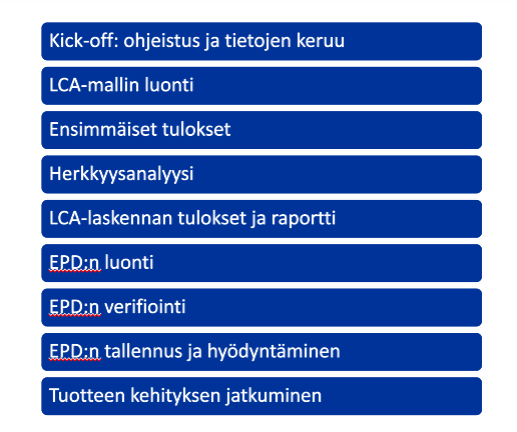Everything you should know about Environmental Product Declarations (EPD)
The Environmental Product Declaration – EPD – is the basis for the environmental aspect of products and fact-based product information, and together these form the basis of companies’ competitiveness. Below, we dive into the basics of it and explain how to help companies develop more environmentally sustainable products.

What does the Environmental Product Declaration (EPD) contain?
An EPD (Environmental Product Declaration) is a document that provides a standardized and comparable way to present a product’s environmental impact. It is based on Life Cycle Assessment (LCA), which analyses the impact of a product “from cradle to grave” – from raw material sourcing to manufacturing, from use to recycling
The document contains detailed information on, among other things, energy and water use, emissions into the atmosphere and water, and waste generation. This information helps to understand the overall environmental impact of the product.
Why are Environmental Product Declarations (EPD) important
EPD is an increasingly important tool for both companies to be transparent about their environmental impact. It helps not only to demonstrate the environmental friendliness of the product, but also to identify opportunities to reduce environmental impact throughout its life cycle.
The results of the life cycle assessment underlying the EPD can also be utilised in production and product development. In practice, both in Finland and the Nordic countries, EPDs are an important part of B2B trade and public procurement.
How are Environmental Product Declarations made?
EPD is created based on standards, product category rules (PCR) and publishing system guidelines. The standards used are ISO 14040/44 and ISO 14025 and, for construction products, EN 15804.
The preparation of the EPD is based on the mapping of potential environmental impacts, which is based on the Life Cycle Assessment (LCA) method. LCA consists of different phases of the life cycle on a case-by-case basis, e.g. the procurement of raw materials, their transport to the place of production, the production process, distribution and disposal/recycling. These steps can also be called information modules A to D. There are various programs for calculations, of which Ecobio uses high-quality SimaPro software. The ecoinvent database is connected to the software, which provides up-to-date data for calculations.
In addition to the calculations, the life cycle assessor compiles a report on the results. The information is then summarized in an EPD, which undergoes an independent, external audit to ensure its accuracy and reliability. The external auditor, i.e. the verifier, verifies the accuracy of the data and the fulfilment of the set requirements, and approves the calculation model, the report of the work and the EPD. The EPD is then ready to be stored on the selected system. These systems include for example The International EPD System and EPD-Norge.
Depending on the complexity of the product and therefore the scope of work, the whole process takes up to 2 – 3 months. An example of a ready-made one can be found here.

Figure. Ecobio service path
Three benefits of using EPD’s in product development
When a company integrates EPD into its product development process, there are several significant benefits:
- Improved resource efficiency: EPD enables companies to accurately identify and measure the environmental impact of their products. This knowledge is invaluable in developing more environmentally friendly and resource-efficient products. By analysing EPD data, companies can plan changes that reduce emissions, energy consumption and waste – and thus also bring monetary benefits.
- Identifying development opportunities: EPD provides a comprehensive view of the entire product life cycle, revealing potential development points. For example, if a particular raw material or manufacturing process is a significant source of emissions, companies may look for alternative, more environmentally friendly solutions. These include, for example, changing the energy used in the so-called “green energy” and increasing the use of recycled raw materials. For the latter, life cycle assessment already provides a good tool for comparing the concentrations of different recycled raw materials, so that the correct concentration and its effects can be seen already on the drawing board.
- Marketing and communication benefits: EPD enables companies to communicate the environmental impact of their products openly and reliably. This increases transparency and improves brand reputation. In addition, as consumers and stakeholders become increasingly aware of environmental issues, EPD acts as a competitive advantage and helps to stand out in the market.
By combining these benefits, EPD becomes an integral part of the company’s product development strategy, supporting sustainability and innovation.
Three steps to implementing EPD in your company
Integrating EPD into a company’s product development process requires strategic planning and collaboration. The following steps will help businesses implement it effectively:
- Integration: The first step is to understand the EPD process and think about how it can be integrated into current product development. This may mean introducing new tools and methods for data collection and analysis. Continuous improvement is possible with the right tools and calculated data.
- Collaboration: Creating an EPD requires multidisciplinary skills. It is a good idea for the company to work with experts, suppliers, subcontractors and manufacturers to ensure that all necessary information is available and analysed correctly. Creating an EPD requires knowledge of the company’s purchase chains.
- Learning: It is useful to study and learn from other companies that have managed to integrate EPD into their product development. These examples can provide valuable insights into how EPD can be adapted to different products and industries.
The implementation of EPD is not just a technical process, it requires a commitment to sustainability and transparency about environmental impacts. When companies commit to this process, they not only contribute to their own sustainability goals, but also help build a more sustainable future.
Ecobio is here to help
EPD plays a significant role in companies’ product development and thus also in the development of their competitiveness. It does not only provide comprehensive information on a product’s environmental impact, but also guides companies towards more sustainable choices and innovations. The introduction of EPD is not only an environmentally responsible act, but also a strategic decision that can strengthen a company’s market position and improve its competitiveness, and even secure its future business opportunities.
Sustainable development and environmental responsibility are at the core of modern business. If your business isn’t already taking advantage of EPD, now is the time to consider implementing it. With it, you can not only demonstrate your commitment to environmental protection, but also develop your products to meet the growing demand for sustainable products. Remember that every step towards more transparent and responsible product development is a step towards a more sustainable future.
The Ecobio team will support you in creating your EPD. Contact us for more information.
Contact Us
We help you balance business and nature
